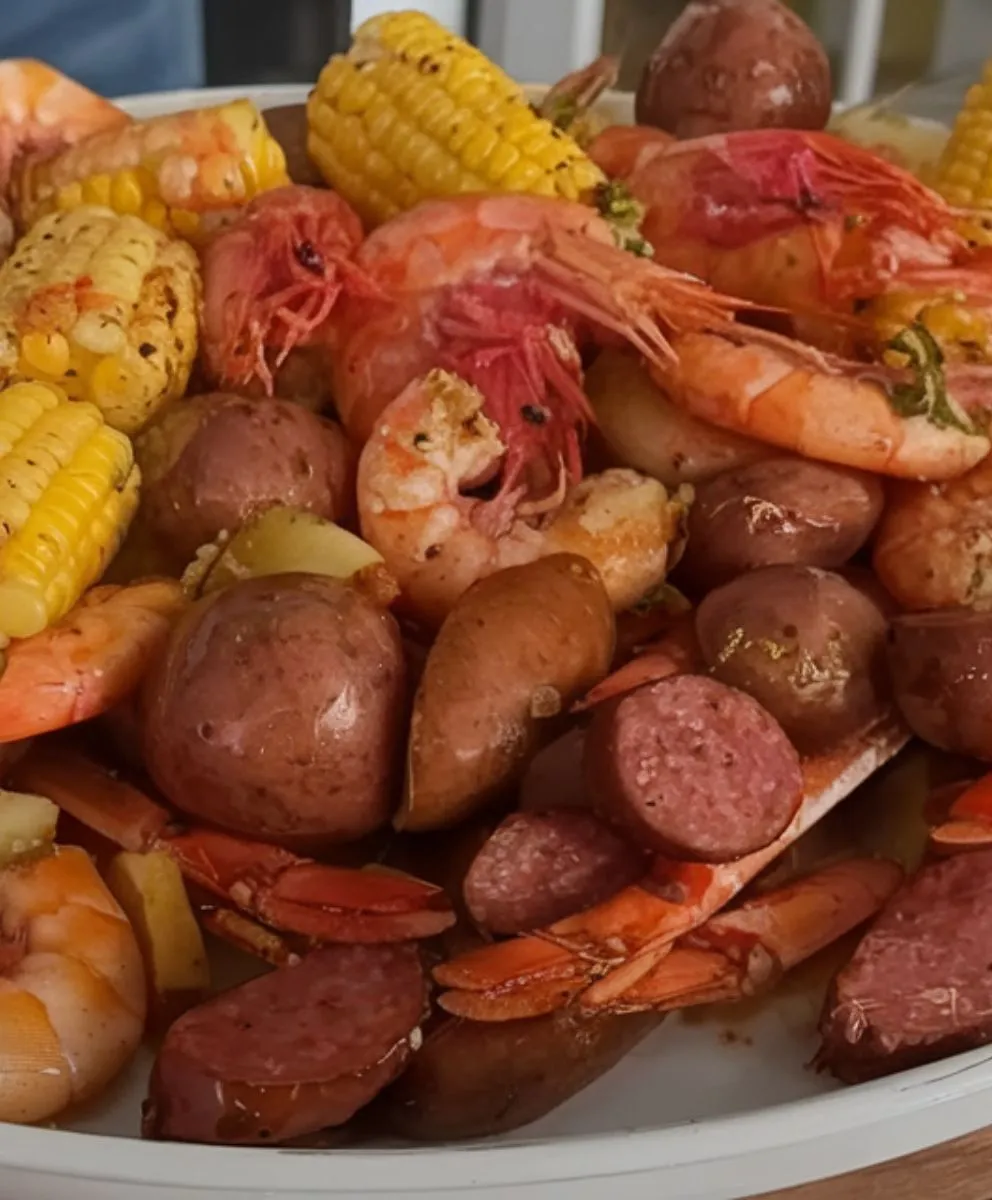Introduction
A seafood boil bag is a delightful, flavorful dish that unites the freshest seafood with hearty vegetables, creating an unforgettable culinary experience. Whether served at a lively backyard BBQ, a cozy family dinner, or a festive gathering, seafood boil bags deliver bold, mouthwatering flavors with every bite. This dish is not just a meal-it’s an event that fills the air with the savory scents of butter, spices, and perfectly cooked seafood boil bag.
What truly sets the seafood boil in a bag apart is its sheer simplicity. With minimal effort and even less cleanup, you can prepare a feast that rivals any restaurant. All it takes is a few fresh ingredients, a generous sprinkle of seasoning, and a bit of time in the oven or on the grill.
Whether you’re making a crab boil in a bag, a crab and shrimp boil, or a shrimp boil in a bag, the beauty lies in how the flavors meld together inside the sealed boil bag. The ingredients cook in their own juices, which helps preserve their natural flavors while intensifying the overall taste.
This hands-off cooking method guarantees a rich, bold flavor profile that makes every bite irresistible. Perfect for any occasion, a seafood mix bag is a stress-free way to enjoy a restaurant-quality meal with friends and family.
What’s a Seafood Boil Bag?
A seafood boil bag is a convenient and modern take on the traditional Southern seafood boil, offering an effortless, mess-free way to indulge in bold, savory flavors. This cooking method involves sealing fresh seafood, vegetables, and seasonings inside a durable oven-safe or steaming bag, where everything cooks together, allowing the ingredients to soak in their own natural juices for maximum flavor.
A typical seafood boil bag includes a mix of shrimp, crab legs, crawfish, or mussels, complemented by corn on the cob, red potatoes, and smoked sausage. These ingredients are generously seasoned with a flavorful blend of Old Bay, Cajun spices, paprika, garlic, and cayenne pepper. The addition of melted butter, lemon juice, and hot sauce provides depth, balancing rich flavors with zesty tang.
Unlike traditional seafood boils that require large pots and constant supervision, a seafood boil bag simplifies the process. By baking or steaming the bag, all the flavors meld perfectly while making cleanup a breeze. Whether you’re craving a fiery crab and shrimp boil, a classic shrimp boil in a bag, or a seafood mix bag, the possibilities are endless.
Ideal for gatherings or a quick weeknight meal, this technique ensures a restaurant-quality crab boil in a bag experience with minimal effort, giving you all the deliciousness of a traditional seafood boil without the hassle.
Essential Ingredients for a Perfect Seafood Boil Bag
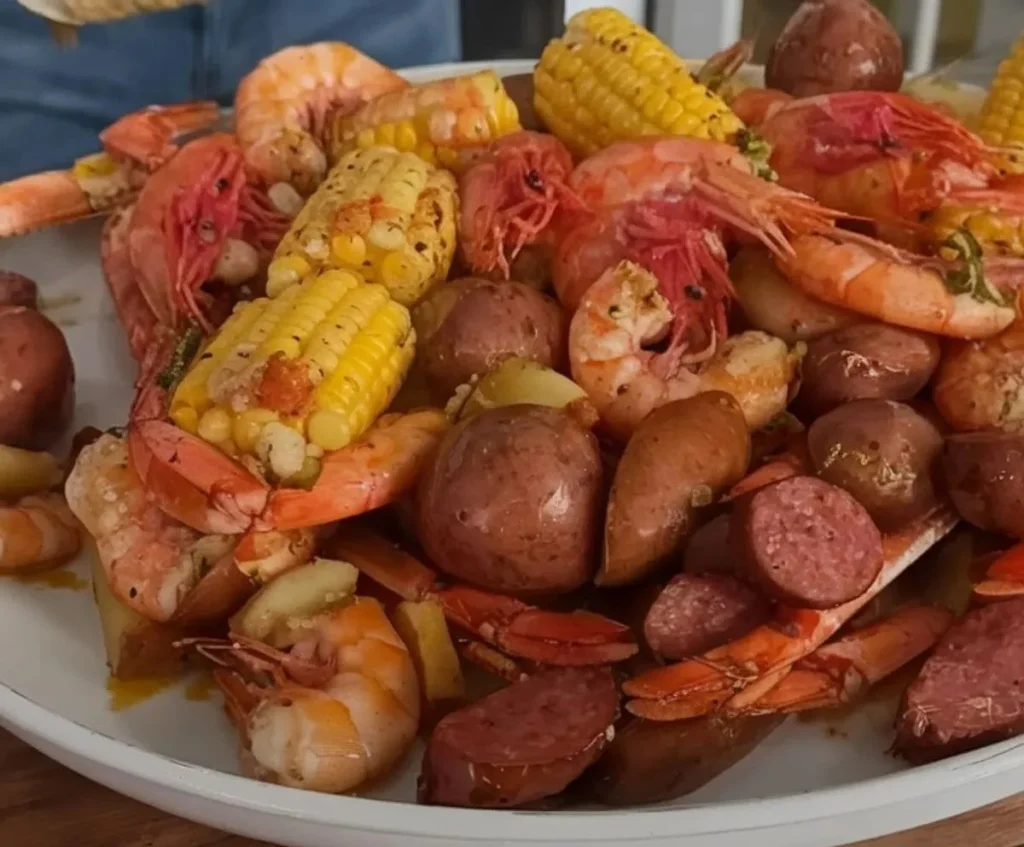
A seafood boil bag brings together fresh seafood, hearty vegetables, and bold seasonings, all infused with rich, buttery goodness. Here are the key ingredients that make this dish truly special:
1- Flavor Base
- Salt – Enhances the natural taste of seafood and vegetables.
- Water or stock – Adds moisture to create steam and deepen the flavors.
- Butter – The foundation of the sauce, ensuring a rich and velvety texture.
- Hot sauce – Brings a touch of heat and tangy depth.
- Lemon pepper – Adds brightness and a zesty kick.
- Seafood seasoning – A blend of spices that complements the natural flavors of seafood.
- Cajun seasoning – Provides smoky, bold, and slightly spicy notes.
- Paprika – Contributes a subtle sweetness and enhances color.
- Granulated garlic – Infuses the dish with a deep garlic essence.
- Cayenne pepper – Adds a fiery heat for those who love spice.
2- Vegetables & Add-Ins
A seafood boil bag isn’t just about the seafood—it’s also about the perfect combination of vegetables and additional ingredients that soak up the rich, spicy butter sauce.
- Red potatoes – These small, waxy potatoes hold their shape well and absorb the flavorful juices as they cook, making them a satisfying addition to the meal. Their mild, earthy flavor helps balance out the heat.
- Corn on the cob – A must-have for any seafood boil. The natural sweetness of corn provides a delicious contrast to the bold spices, and the juicy kernels burst with flavor after soaking in the butter sauce.
- Garlic (whole, halved) – Slowly releases its deep, rich flavor into the boil, adding an extra layer of warmth and aroma. Softened garlic cloves can also be spread onto the seafood for extra flavor.
- Onion – Provides a subtle sweetness and enhances the overall depth of the dish. As it cooks, it caramelizes slightly, blending seamlessly into the broth.
- Mushrooms – These little sponges soak up every bit of buttery, spicy goodness, adding a rich umami flavor that complements the seafood perfectly.
- Hard-boiled eggs – A popular addition in Cajun-style seafood boils, eggs absorb the buttery seasoning and provide a creamy, hearty contrast to the dish’s bold flavors. They also serve as a great vehicle for extra sauce.
4- The Proteins – The Star of the Show
The seafood and protein elements are what make a seafood boil bag truly shine. These ingredients each bring their own unique textures and flavors to the dish, creating a well-rounded and satisfying meal.
- Smoked sausage – A savory, smoky element that pairs beautifully with seafood. The bold, seasoned flavor of sausage, especially varieties like Andouille or Kielbasa, balances out the natural sweetness of shrimp and crab.
- Snow crab clusters – Tender, slightly sweet, and packed with flavor, crab legs are a staple in any seafood boil. As they steam in the butter and seasonings, they soak up all the aromatic spices, making every bite a delight.
- Shrimp – Juicy, plump, and quick-cooking, shrimp are the perfect protein to complement the bold spices of the boil. They absorb the rich, seasoned butter effortlessly, ensuring every bite is packed with flavor.
5- The Finishing Touches – Bringing It All Together
The final ingredients add brightness and an extra layer of flavor that ties the whole dish together.
- Lemons (halved) – A squeeze of fresh lemon juice cuts through the richness of the butter and spices, balancing the flavors beautifully. Lemon also enhances the natural sweetness of the seafood.
- Extra melted butter for dipping – While the seafood is already coated in a flavorful buttery sauce, serving extra melted butter on the side allows for additional indulgence.
- Fresh parsley (optional) – A sprinkle of fresh herbs at the end adds a pop of color and freshness to the dish.
Tips for Making the Perfect Seafood Boil Bag
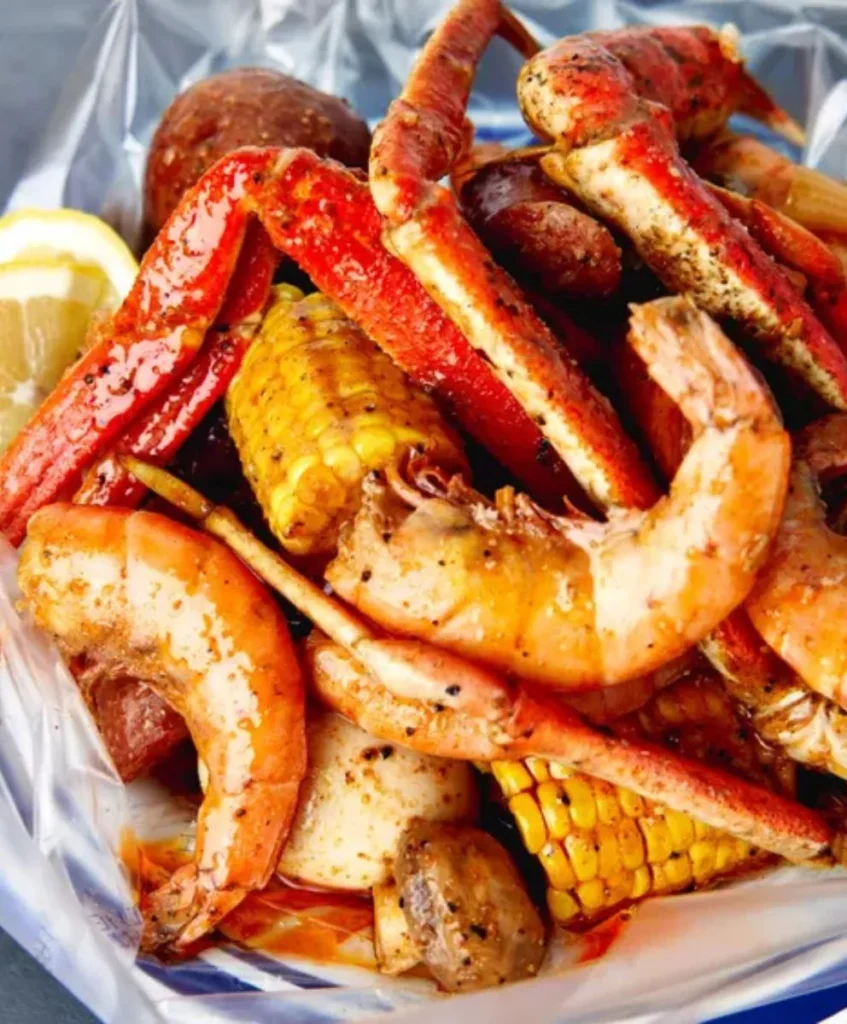
Creating a delicious seafood boil bag is all about balancing flavors, textures, and cooking times. Here are some tips to help you make the ultimate seafood boil at home.
- Layer Ingredients Properly
Start with hardier ingredients like potatoes, corn, and garlic at the bottom. These take longer to cook. Layer seafood like shrimp and crab on top to ensure everything is cooked evenly.
- Don’t Overcrowd the Bag
Leave space in the bag for steam to circulate. Overcrowding can lead to uneven cooking, so if needed, use multiple bags for larger quantities.
- Tie the Bag Tightly
Seal the bag tightly, but leave room for steam to circulate. Double-bagging can prevent leaks, especially with sharp crab shells.
- Preheat the Oven
Preheat your oven to 400°F (200°C) to ensure even steaming. Position the rack in the lower third for optimal cooking.
- Use a Baking Dish
Place the bag in a baking dish to catch any leaks or excess liquid during cooking.
- Add Fresh Lemon
Once the bag is out of the oven, squeeze fresh lemon juice over the boil for an added citrus kick.
What Type of Bag to Use
Selecting the right bag for your seafood boil bag ensures that the ingredients cook evenly and flavors are locked in. Several options are available based on cooking method and preference.
Oven-Safe Bags: Made from heat-resistant nylon or polyester, these bags trap steam and moisture in the oven, creating a flavorful cooking environment for seafood and vegetables.
Steaming Bags: Ideal for quick cooking, steaming bags have small holes for steam to escape, ensuring even cooking without overcooking delicate seafood. They are perfect for grilling or stovetop use.
Reusable Silicone Bags: Durable, eco-friendly, and heat-resistant, silicone bags can be washed and reused. They provide even heat distribution, ensuring tender, juicy seafood every time.
Heavy-Duty Plastic Bags: Affordable and effective, these bags can hold large quantities of seafood and vegetables. Choose BPA-free plastic bags safe for high temperatures.
Specialty Seafood Boil Bags: Designed specifically for seafood boils, these bags often feature convenient ties or perforated areas to enhance steam circulation, making them perfect for crab and shrimp boils.
Choosing the right bag ensures your seafood boil bag is cooked to perfection with minimal mess.
How to Tell When the seafood boil bag is Done/Cooked
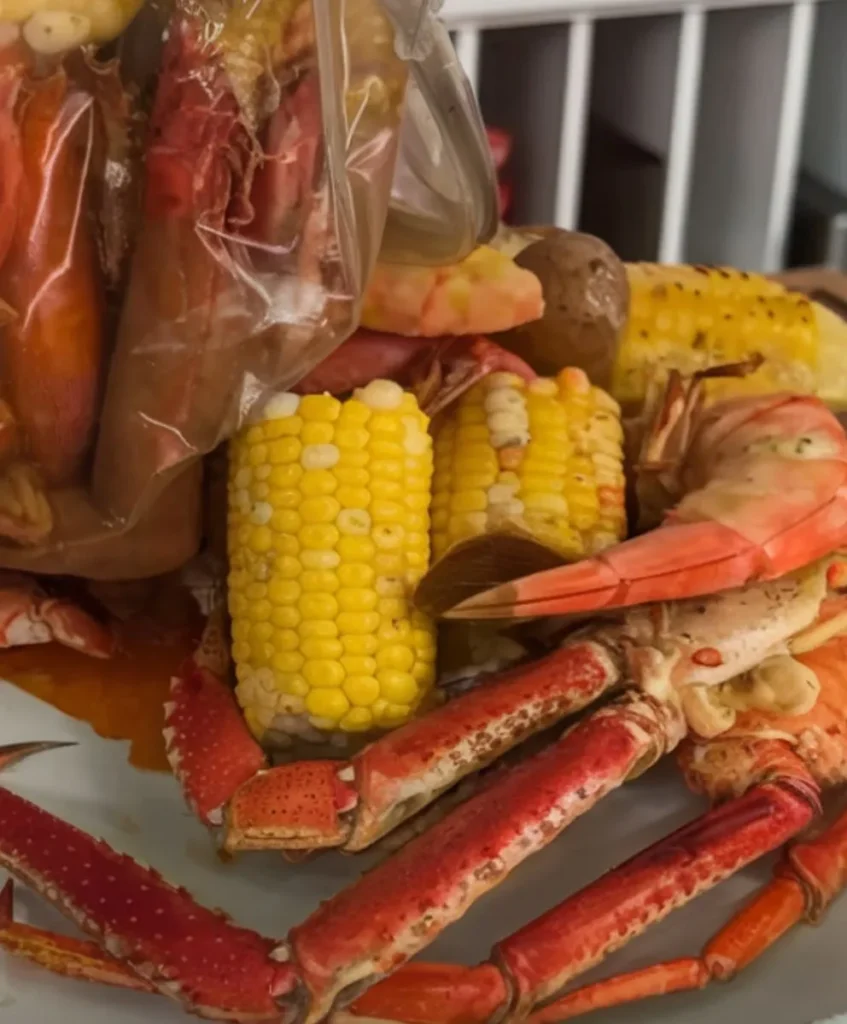
Cooking seafood to perfection is key when preparing a seafood boil bag. The blend of shrimp, crab, sausage, potatoes, corn, and other ingredients requires attention to detail to ensure the seafood is perfectly cooked while maintaining the integrity of all the components. Here’s how to tell when the seafood in your boil is done:
- Shrimp
Shrimp are the easiest to monitor and the quickest to cook. In a shrimp boil in a bag, shrimp change color from translucent to a vibrant pink or red as they cook. The best way to tell if they’re done is by checking their shape—cooked shrimp form a tight “C” shape. If they curl into a complete circle or “O”, they’ve likely been overcooked. They should also have a firm texture, but not rubbery.
- Snow Crab Clusters
Snow crab legs are cooked when their shells turn bright red or orange. To check for doneness, gently pull on the legs. If the meat inside flakes easily and appears opaque, it’s ready. If the crab meat is translucent, it needs a bit more time. The meat should be tender and should easily separate from the shell when you gently pry it open.
- Smoked Sausage
While the sausage doesn’t need to be as closely monitored as seafood, it’s important to make sure it’s fully cooked and heated through. It should have a nice, browned exterior and a slightly crispy texture. The sausage should be firm and have absorbed the seasoning from the boil.
- Red Potatoes
Though not technically seafood, red potatoes play a crucial role in the seafood mix bag. They’re done when they are fork-tender, meaning the fork easily pierces through the potato. These potatoes hold their shape well during the cooking process, making them perfect for a seafood boil in bag.
- Corn on the Cob
Corn is done when it’s tender but still has a slight bite. The kernels should be plump and juicy. Corn on the cob should retain its sweet flavor and slightly crisp texture after cooking, adding a satisfying crunch to the boil bag.
- Mushrooms
Mushrooms in a seafood boil bag should be tender but not mushy. When fully cooked, they will have absorbed the buttery, spicy flavors of the boil, and their texture will be soft but firm enough to hold their shape. The mushrooms should not be rubbery or dry.
- Hard-Boiled Eggs
If you add hard-boiled eggs to your boil, they should be completely cooked through—this means the yolk will be firm and fully set. Since they’re added after cooking, they simply need to be heated through in the bag to absorb the flavors from the seasoning and butter
Serving and Storage Tips for Seafood Boil Bag
A seafood boil bag is a flavorful, interactive meal that’s perfect for any gathering. With the right tips, you can make your seafood boil experience even more enjoyable while ensuring your leftovers stay fresh and tasty.
Serving the Seafood Boil Bag
1. Create a Fun, Hands-On Experience
For a memorable meal, serve the contents of your seafood boil bags directly on a large platter or spread it out on butcher paper. This style encourages guests to dig in with their hands, making it a fun and casual dining experience. Make sure to have plenty of napkins or wet wipes handy for easy cleanup. Garnish the boil with fresh parsley or lemon zest to add a refreshing touch of color and brightness.
2. Offer Dipping Sauces
A variety of dipping sauces will elevate the flavors of your crab and shrimp boil. Try serving garlic butter, Cajun remoulade, or a tangy lemon aioli to balance the rich, spicy notes. If your guests enjoy a little heat, include some hot sauce for a fiery kick. These options will complement the savory spices of your seafood boil in a bag perfectly.
3. Pair with Simple Sides
To round out the meal, pair your shrimp boil in a bag with light, refreshing sides like a crisp green salad, creamy coleslaw, or warm, fluffy cornbread. These simple sides will provide a cool contrast to the bold flavors of the seafood mix bag, making the meal well-rounded and satisfying.
Storing Leftovers : seafood boil bag
1. Cool and Store Properly
After the meal, allow any leftover Seafood Boil Bag to cool before storing it in an airtight container. Refrigerate for up to three days to maintain freshness. If you plan to keep it longer, freeze the seafood and vegetables in a freezer-safe bag for up to three months.
2. Reheat with Care
To preserve the delicate texture of the Seafood Boil Bag, reheat leftovers in a steamer or in the oven at 350°F. Avoid microwaving, as it can make the seafood rubbery and dry, which can detract from the meal’s delicious flavors.
3. Store Extra Sauces Separately
If you have any leftover sauce from your crab boil in a bag, store it separately in small containers. It will keep fresh for up to seven days in the fridge and can be used to enhance the flavor of other dishes.
PrintSeafood Boil Bag
A Seafood Boil Bag is the easiest way to bring bold, seafood flavors to your table—perfect for casual gatherings or family dinners.
- Prep Time: 15 mins
- Cook Time: 50 mins
- Total Time: 1 hr 5 mins
- Yield: 6 to 8
- Category: Dinner
- Method: Baking (in a bag)
- Cuisine: American
Ingredients
2 teaspoons salt – Enhances the natural flavors of the seafood and vegetables.
1/2 cup water or stock – Provides the necessary moisture to steam the ingredients, infusing them with richness.
1 1/2 cups butter – The heart of the boil; melted butter carries the spices and adds a velvety texture to the dish.
1/4 cup hot sauce (such as Crystal® hot sauce) – Brings a balanced heat that enhances, rather than overpowers, the seafood.
2 tablespoons lemon pepper – Adds a bright, citrusy note with a subtle kick of black pepper.
2 tablespoons seafood seasoning (such as Old Bay® Original) – A classic blend that delivers a perfect mix of heat, salt, and aromatic spices.
1 1/2 tablespoons Cajun seasoning – Infuses the dish with bold, smoky flavors and a touch of warmth.
1 tablespoon paprika – Deepens the color of the dish while contributing a mild, earthy sweetness.
2 teaspoons granulated garlic – Intensifies the garlic undertones without overwhelming the dish.
1 teaspoon cayenne pepper – Provides an extra punch of spice for those who love a little heat.
2 pounds small red potatoes – These hold their shape well and absorb all the flavorful juices.
3 ears corn, cut into thirds – Sweet, juicy corn balances the spice and adds a satisfying crunch.
1 head garlic, halved lengthwise – Slowly infuses the broth with its aromatic essence.
1 small onion, chopped – Adds depth and a mild sweetness as it steams.
8 ounces whole button mushrooms – Absorb the buttery, spicy flavors while adding an earthy touch.
4 large hard-boiled eggs – A classic addition to a seafood boil, offering a creamy contrast to the bold flavors.
1 pound smoked sausage, cut into 2-inch pieces – A smoky, savory element that complements the seafood.
4 snow crab clusters – Sweet, succulent crab legs that soak up all the buttery seasoning.
2 pounds shrimp – Tender, juicy shrimp that cook quickly and absorb all the spices.
2 lemons, halved, divided – One half is squeezed into the boil for acidity, while the other half is served on the side for a fresh burst of citrus.
Instructions
Start by preparing your vegetables, which will form the hearty base of the seafood boil bag. Take your small red potatoes and place them in a large pot. Cover the potatoes with water, making sure the water level is about 3 inches above the potatoes. Add 2 teaspoons of salt to the water—this will help season the potatoes and vegetables as they cook.
Set the pot over medium-high heat and allow it to come to a boil. Once boiling, let the potatoes cook for about 5 minutes before adding the corn (cut into thirds) and halved garlic cloves. Continue to boil the mixture until the potatoes are tender, which should take approximately 10 more minutes. Once everything is cooked through, drain the water and set the vegetables aside.

In a deep skillet or saucepan, heat the pan over medium heat. Add the smoked sausage, sliced into 2-inch pieces. Increase the heat to medium-high and cook until the sausage is browned on both sides, which should take around 3 minutes. Once browned, remove the sausage from the pan and set it aside. The browned sausage will impart a rich, smoky flavor that will infuse the entire dish later.

While you’re working on the other steps, preheat your oven to 400°F (200°C). Set the oven rack in the lower third of the oven, as this position will help the bag steam evenly and cook everything to perfection. Preheating ensures that when it’s time to bake the seafood bag, it’ll be hot and ready to work its magic.
Next, add the chopped onion to the skillet, using the sausage drippings for extra flavor. Stir the onion constantly and cook it until it starts to soften, which should take about 3 minutes. This allows the onion to release its natural sugars and enhance the savory profile of the dish. Once the onion begins to soften, pour in a splash of wine to deglaze the pan, scraping up any delicious browned bits stuck to the bottom. This step enhances the flavor, giving it more complexity and richness. Stir in water to loosen up the mixture and create a flavorful liquid base.
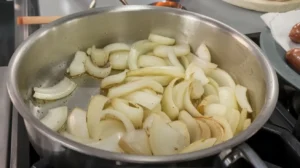
To build the bold, aromatic sauce that will bring the entire boil together, it’s time to add the seasonings. Into the skillet, add butter, hot sauce, lemon pepper, Old Bay seasoning, Cajun seasoning, paprika, granulated garlic, and cayenne pepper. Reduce the heat to medium and cook while stirring constantly until the butter melts and the sauce is smooth and well-combined. Remove the skillet from the heat once everything is blended. The sauce should be a perfect balance of buttery richness, spice, and acidity.

Now comes the fun part—assembling the seafood boil bag! Take a large oven or turkey cooking bag and open it inside a large bowl or pot, letting the top edge hang over the rim to make filling easier. Begin by layering the cooked corn and potatoes at the bottom of the bag. Follow this with mushrooms, hard-boiled eggs, snow crab clusters, shrimp, and the browned sausage.
Once everything is in place, pour the prepared butter sauce over the top, ensuring every ingredient is generously coated. Squeeze the juice of two lemon halves into the bag for a burst of fresh citrus. Carefully tie the bag tightly at the top, leaving room for the steam to circulate and cook the ingredients evenly. If needed, double bag the contents to prevent any punctures from the sharp crab legs or seafood. Gently toss the contents inside the bag to coat everything with the sauce.

Place the filled bag into a large baking dish to catch any potential leaks. Transfer it to the preheated oven and bake for about 30 minutes, or until the bag is filled with steam and the shrimp are fully cooked, turning opaque. The crab should also be cooked through at this point. The steam inside the bag will cook everything gently while preserving the rich flavors.

After 30 minutes, carefully cut open the seafood boil bag, allowing the fragrant steam to escape. Squeeze the remaining lemon halves over the dish for an extra burst of citrus.
Serve immediately, and enjoy the decadent, bold flavors of the seafood boil. You can either serve the contents directly from the bag or transfer them to a large platter for a more elegant presentation. Don’t forget to offer extra napkins—this meal is all about getting your hands messy and enjoying the flavorful experience!
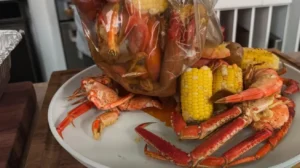
Nutrition
- Serving Size: 6
- Calories: 1102
- Sugar: 15g
- Sodium: 5873mg
- Fat: 61g
- Saturated Fat: 29g
- Carbohydrates: 69g
- Fiber: 10g
- Protein: 73g
- Cholesterol: 654mg
Frequently Asked Questions
What’s the best way to reheat a seafood boil without using a bag?
To reheat a seafood boil, heat it on the stovetop with a bit of water or butter, or bake at 350°F covered with foil for 10-15 minutes until warmed through.
Seafood bake vs. seafood boil
A seafood bake and a seafood boil both showcase seafood, but in different ways. A seafood bake combines seafood with butter or cheese, baked to a creamy, tender texture, perfect for cozy meals. A seafood boil, on the other hand, mixes seafood, veggies, and bold spices in a large pot or bag, creating a flavorful, interactive dish. The bake offers a rich, refined taste, while the boil is lively and spicy, making both unique ways to enjoy seafood.
Can I put the seafood boil bags into boiling water?
Yes, you can put seafood boil bags into boiling water. The bag will steam the ingredients, helping them cook evenly while locking in flavors. Just ensure the bag is properly sealed to prevent spills.
Is it okay to use frozen seafood for a seafood boil in a bag?
Yes, you can use frozen seafood for a seafood boil in a bag. Just thaw it properly in the fridge or with cold water before cooking. Frozen seafood may take a bit longer to cook, but it will still work great in the boil.
Why put eggs in a seafood boil?
Eggs in a seafood boil absorb the spices and butter, providing a creamy contrast to the bold seafood. They add variety, balance the richness, and make the dish more filling.
Conclusion
A seafood boil bag is more than just a meal; it’s a fun and social experience. With minimal cleanup and maximum flavor, this dish is perfect for gatherings and celebrations. Whether you opt for a seafood boil bag, a seafood mix bag, or a shrimp boil in a bag, the possibilities are endless. Customizing it with spices, butter, and your favorite seafood options ensures every bite is packed with savory goodness.
The best part is the flexibility. You can experiment with different seasonings, add unique vegetables, or even try new seafood varieties. The seafood boil bag is a blank canvas for your culinary creativity.
For a twist, pair your seafood boil bag with a Sushi Cake—a layered, visually stunning dish that contrasts beautifully with the bold flavors of the boil.
Why not give it a try? Gather your ingredients, get creative, and dive into this flavorful, hands-on meal. Whether you’re a seafood lover or a newcomer, the seafood boil bag will impress. Enjoy the experience and let your taste buds explore the endless possibilities.
Leave a comment
Your email address will not be published. Required fields are marked*

